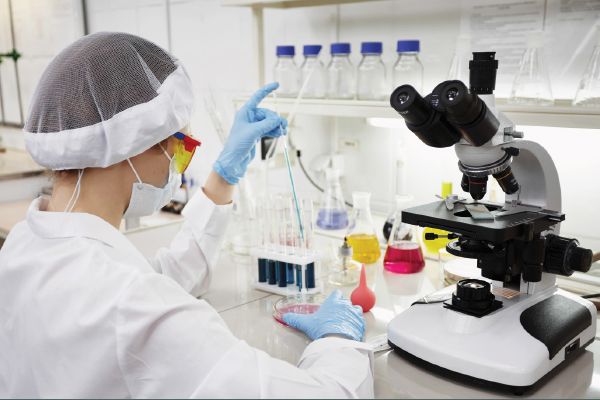In the last 2 blogs, we discussed the below components of the Diagnostics Industry ecosystem.
- Diagnostic company: The individual companies in the Diagnostic Industry
- Professionals: They work in the Diagnostic companies
- Suppliers: They are vendors supplying equipment and supplies needed for operation of Diagnostic companies
- Customers: They are the end users who pay and receive the services from the Diagnostic companies.
- Regulations: These are government bodies, agencies and institutions that regulate the industry.
- Information Technology (IT): Helps to integrate the operations in Diagnostic companies
In this blog, we will continue to discuss the last and important component Logistics.
Source: The contents of this entire blog is picked from the below three DRHP:
- Thyrocare IPO DRHP, Page 110 – 111
- Dr Lal Pathlabs IPO DRHP, Page 117 – 118
- Metropolis IPO DRHP, Page 129 – 130
(Feature image credits: https://ehealth.eletsonline.com/2021/02/future-prospects-of-the-indian-diagnostics-sector-the-resurgence-post-pandemic/)
Brief Background of this Blog Series
Diagnostics Industry was of interest to me since 2017. However, I could spend dedicated time only during 2021 to study this industry. The contents that you see in the coming blogs were mined from Annual Reports, Concalls, RHP, Management interviews and a few Twitter spaces by Mr Aditya Khemka and Dr Velumani.
Hi, This is Venkatesh. I write on Personal Finance, Stock Investing, Productivity and Time Management. You will be interested to read more about me and the purpose of my website.
If you are interested in these topics do subscribe to my blogs. You would maximum receive 4 to 5 emails a month.
You might also be interested to read these related articles:
Overview of Logistics
Logistics play a very important and crucial role in Diagnostic Chains (Both regional and PAN India). This may not be applicable to standalone centres. However Diagnostic Chains have sample collection centres in multiple locations. The collection centres could be their own centres/labs (Belonging to the Diagnostic company), franchises, home collection, hospital etc. The samples from all the locations are taken to one nearby central lab for testing. Here logistics play an important role.
Requirements of a Logistics System
The minimum requirements of such logistics systems are:
- A strong and reliable logistic to transport the samples from collection centres to labs where testing is done.
- Deliver the samples on time before it may degrade.
- Ensure that the samples do not get degrade or get damaged during transport. This may need to have the proper mechanism of refrigeration, cooling, preserving and handling the samples during transport.
- Lowest possible turnaround time between the time of collection and reporting back the results. This aspect could be crucial to the life of a patient, where the doctor awaits test results to start the treatment. Diagnostic chains with lowest turnaround time had a competitive advantage over other players.
Diagnostic chains adopt the hub-and-spoke model to extend their catchment area and scale the volumes. The benefits of this model are:
Scale
This model helps in collection of specimens across multiple locations. This generates more volumes leading to greater economies of scale. This ensures that equipment is not idle. In case of Diagnostics, a machine waiting for a sample is a liability.
A standing machine is a liability, a running machine is an asset. Dr. Velumani in Twitter Space
Flexible Expansion
Diagnostic chains can easily and rapid expand their network through addition of satellite laboratories and collection centres. This further enhances the scale. As a benefit to the society, a common man in any part of the country is able to get access to these tests near their location.
We will understand more of the component of Hub and Spoke model and its operation, to appreciate the importance of logistic support.
Hub and Spoke Model
This model typically has 4 components: (1) A National reference lab, (2) Regional or reference lab, (3) Satellite labs and (4) Collection Centers (CC).
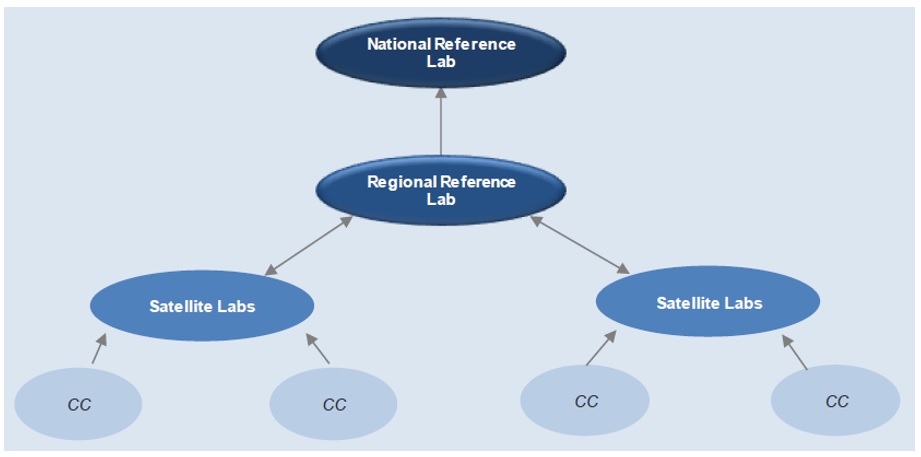
National Reference Lab
- This is located centrally, usually in a large metropolitan area and typically serve as the corporate headquarters of diagnostic chain companies.
- The national reference labs are highly equipped to conduct routine, specialized pathology and imaging tests.
- They may be spread over an area of 2,000-3,000 square feet, having a work area, front office, back office and sample collection area (Note: Size may differ as per equipment installed and tests analyzed or services offered)
- All operations between the National reference lab and its spokes are centrally coordinated through a central-server applied Laboratory Information Management System (LIMS)
- Reports are sent to patients through: (1) Collection centres, (2) Satellite lab or (3) Upload in portal to be viewed online.
Regional Reference Lab
- They are similar to National Reference Lab and situated in large metropolitan cities.
- It act as regional hubs, which accumulate samples from satellite labs and collection centers across the country.
- Like National reference labs, Regional reference labs also offer comprehensive and specialized testing facilities.
Satellite Labs
- Satellite laboratories are not equipped to conduct advanced pathology and radiology and offer a limited range of services, mainly acting as feeders regional reference labs and national reference labs.
- Based on the complexity of the test, a satellite lab may choose to transfer samples to regional reference lab or national reference lab (whichever is nearer).
- A typical satellite lab is usually able to cater to a catchment area with a two to five km radius.
- The reach of the satellite lab expands to 15-20 km radius as collection centers act as spokes
- Thus, a collection center is usually able to cater to an area with a three to five km radius
Refer the below visualization for better understanding
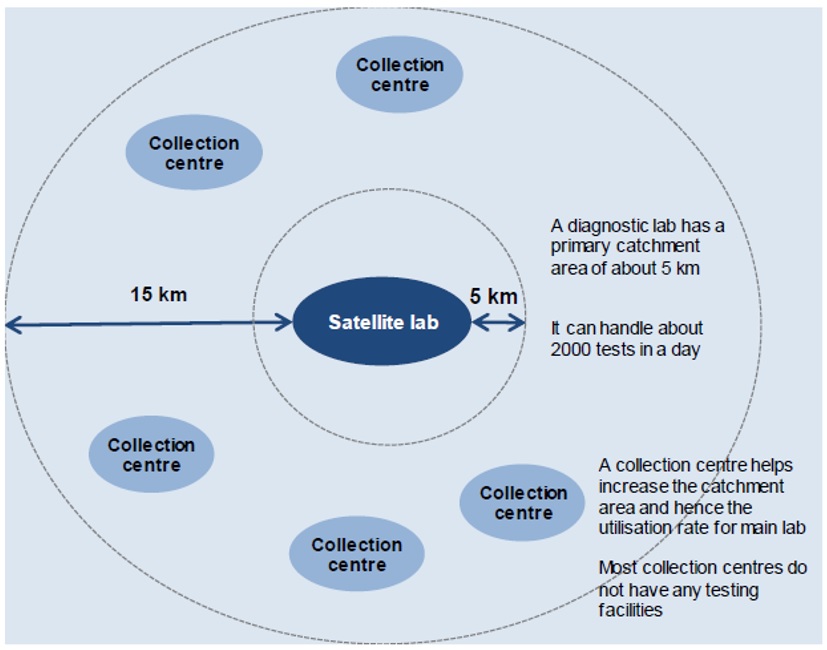
Collection Centres
- Collection centers are located in hospitals, nursing homes, pathology labs, doctors’ clinics, prime commercial properties and retail spaces among other places.
- The centers may be company-owned or franchised.
- A franchise usually pays a franchise fee, around ₹30,000-50,000, to get the license to operate a collection center for the satellite lab.
- Collection centers do not carry out any testing, and are involved only in the collection and forwarding of patient samples to a satellite or reference lab.
- The centers usually have basic equipment in the form of a refrigerator and centrifuge, and employ minimal staff, such as a receptionist, lab technician, attendants and delivery staff.
A sample representation of flow of sample from patient (Individual or Institutional) to different labs by this Hub and spokes model is as below:
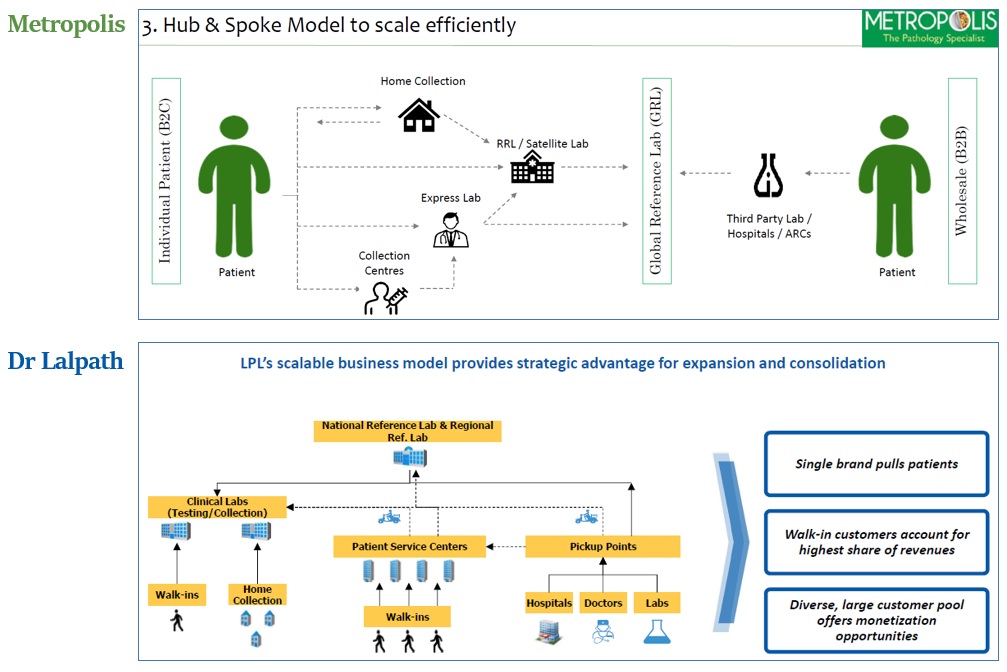
Source: Metropolis, Investor presentation and Dr Lal Pathlabs corporate presentation
Operation of Logistics
Collection Centres
- Collection centers pick up samples, either directly from customers’ homes or from the patients at the center itself or from other labs, hospitals etc.
- The samples are stored as per procedures laid down to maintain the samples’ integrity. For example, whole blood samples are safely collected in vacuum-filled sterile tubes called ‘vacutainers’, appropriately labelled or barcoded, and stored at the appropriate temperature of 4-25 degrees Celsius depending on the type of test recommended.
- Samples from all collection centers of a particular area of operation are rounded up at a single staging area in the city.
Satellite Labs
- Every pick-up person from the satellite lab has a specified area of operation and usually handles five to ten centers within a four to five kilometer radius area.
- Then, a single delivery person takes charge of the samples and sends them to the reference lab or satellite labs based on the type of teste:
- In case of routine test, the samples could be sent satellite labs or reference labs whichever is near
- In case of specialized tests, the samples would be sent to National or Regional reference labs where the equipment are available for such tests.
Transport of Samples
- Mode of transport of samples:
- Usually transported by road on two-wheelers or other modes of transport such as rail and/or surface
- Diagnostic centers may also opt for air logistics by flying samples collected at their collection centers in other cities.
- Sample transport usually takes from one hour to one day depending upon the distance between the area of collection, the final drop point, mode of transport and the turnaround time during which the sample can be kept intact.
- Samples may be collected during the day, and then transported overnight to the reference lab.
In terms of reporting test results, diagnostic labs may use both online and hard-copy formats.
A representative illustration of how a sample collected at a collection centre from a rural place gets transported to a national reference lab through aircraft.
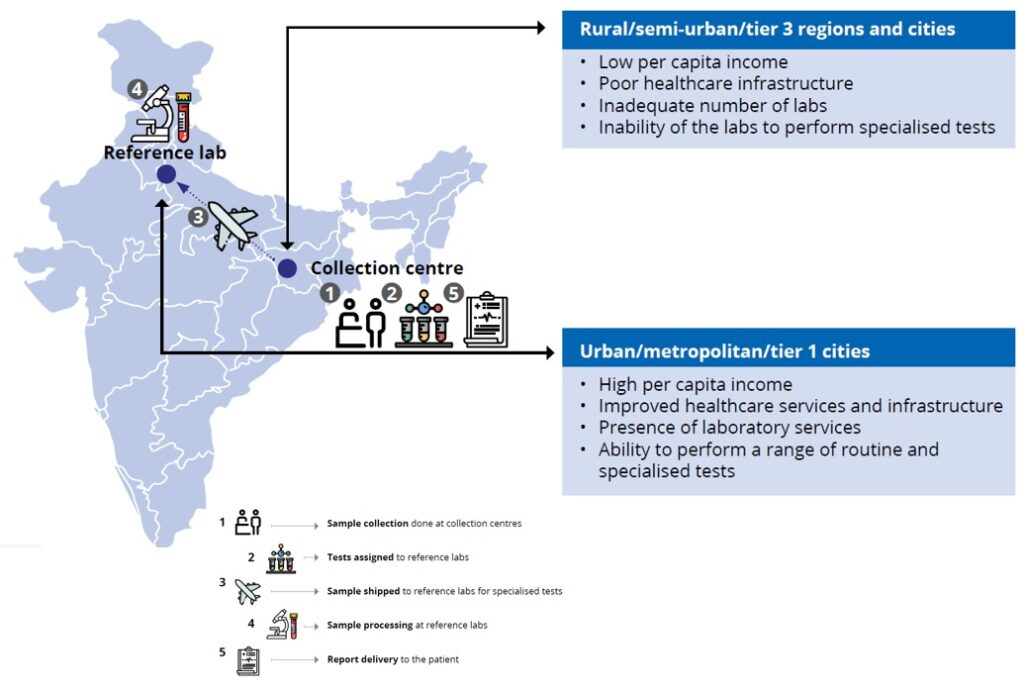
Below is the snap of the entire ecosystem that we covered in this and the last two blogs.
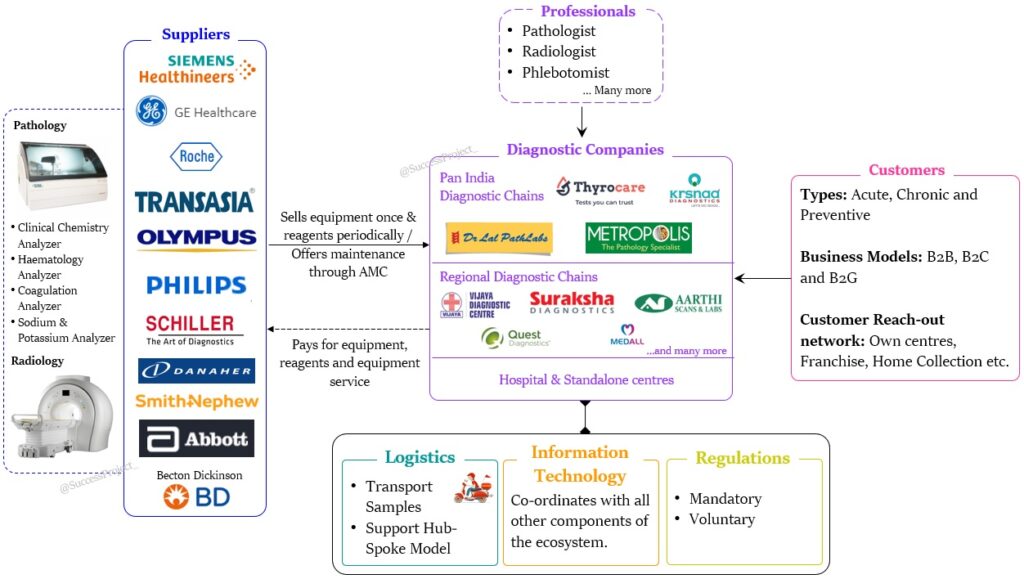
To close…
In this blog and the last blog, we discussed the 7 components of the Diagnostics Industry ecosystem. This completes this topic. In the next blog, we will discuss more interesting topics for investors. Yes! The different insights for investors.
Hope you found this blog useful. Do share my blogs with your friends, peers and fellow investors.

